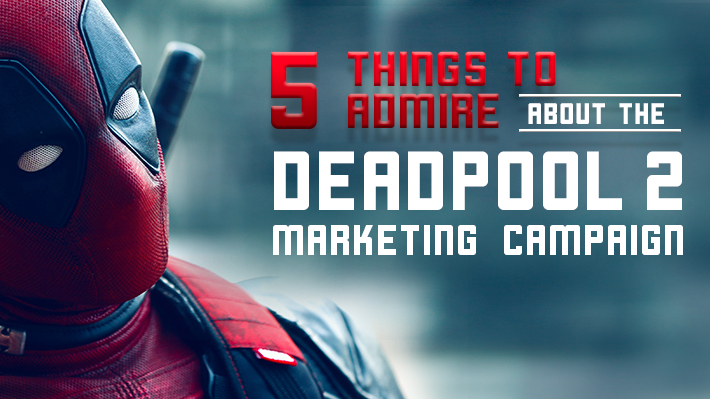Five things to admire about the Deadpool 2 marketing campaign
Where does a knowing, cynical, genre-puncturing superhero go to recruit a “super-duper” team of sidekicks? LinkedIn of course. It was one of the best lines in a fantastic final trailer for Deadpool 2, that took meta movie marketing to a new level. And as a big fan of the first movie, it definitely got my attention when the clip started circulating online.
I’ll admit I was like a big kid when I heard that Deadpool’s unique take on the Marvel universe includes the world’s biggest professional network. As a marketer though, the really interesting thing wasn’t the fact that LinkedIn makes it into the final cut of the movie. It’s the role it has been playing as a content and storytelling platform within a unique marketing campaign.
Now, there are online commentators and pundits who have been getting a bit irritated by Deadpool and Ryan Reynolds’ unique approach to launching a film. They couldn’t understand why they were watching months of random clips from Deadpool interrupting Hugh Jackman’s video calls, dropping in on David Beckham or brilliantly parodying the legendary Joy of Painting presenter Bob Ross. They were suspicious, that they very rarely got to see actual clips from the movie. They assumed that Deadpool 2 must be a turkey and that the marketing campaign was desperately trying to distract potential audiences from the the fact.
I’m not one of those people. In my view, this launch campaign hasn’t just been perfectly aligned with the convention-shredding ethos of the film itself. It’s a marker for just how effective original and inventive content can be in building excitement and awareness. The Deadpool 2 material hasn’t just shown respect for the audience. It’s done so by rewriting the rules of how filmmakers talk to cinemagoers, and by adding a heap of discoverable value in the process. It’s a major reason why Deadpool 2 has already made more than three times its budget at the box office within a week of its release, and is on course to be one of the most successful comedy sequels of all time.
Here are the five things about this campaign that I particularly admired - and that I think any content marketer can draw inspiration from. They add up to a landmark launch campaign that might just change how film studios approach their marketing, and prove to anybody that there’s value in finding original ways to tell your story on different platforms:
Differentiation through different forms of content
When you’ve spent hundreds of millions of dollars making a film, it seems logical to leverage as much value as possible out of that existing content when it comes to your marketing. That’s the conventional assumption behind almost every film trailer you’ve ever seen: we’ll show you the best bits, arrange them in a way that gives you an impression of the narrative arc, include a couple of really zingy one-liners - job done! The trouble with these conventional trailers of course, is that it’s actually very difficult to differentiate your offering. Any film looks good when you compress it down to two minutes of highlights, and it’s very difficult to communicate the nuance that makes your particular movie-going experience unique.
Deadpool 2 took the opposite approach: rather than being the centrepiece of the marketing campaign, the film footage itself was the least important aspect of it. Instead, we got wholly original pieces of content that each delivered a different form of entertainment in exchange for the audience’s attention. They reminded people of the fundamental Deadpool brand promise (knowing, cynical, rude, fourth wall-breaking humour) without endlessly repeating lines that we’d all be sick off by the time the actual film came out.
That’s the thing about great content marketing - it’s produced by people who fundamentally love the experience of delivering value for an audience, and finding new ways to do it.
Offering unexpected perspectives on the story
Because Deadpool 2 was creating fresh content from scratch, it had a free hand when it came to telling its story from different perspectives. Most movie marketing has one obvious brand spokesperson: the hero or title character. They use this obvious brand spokesperson on every channel they venture onto. When it came to its long-running series of irreverent video clips, Deadpool 2 played it straightish in this regard: it was Reynolds’ character appearing in all of those quirky trailers. However, as soon as it headed onto social media, things changed. It wasn’t Deadpool or Wade Wilson who got their own Twitter feed and LinkedIn profile; it was ‘Peter W.’, Regional Sales Manager at Excalibur Cutlery and unlikeliest member of the X-Force team put together during the film.
Peter is nowhere close to being a lead character - but he is the most fundamentally normal character in the script, and that provided the marketing campaign with a totally different kind of humour and storytelling asset to play with. Peter’s LinkedIn profile is equal parts funny and a bit sad. You cringe when you read about the quality time his wife spends with her personal trainer or how he balances his time between beekeeping and a marriage he believes to be mutually loving. You feel for this guy and there’s a nuance there that makes finding out how he fits into the Deadpool 2 story all the more intriguing.
Tailoring storytelling to different platforms - but not in the way you’d expect
The Peter-based social media strategy also allowed the campaign to tailor its approach to both Twitter and LinkedIn, but in a deliberately irreverent way. Peter’s approach to personal branding on LinkedIn is almost right - and almost right in exactly the way you’d expect of a slightly nerdy, slightly off-the-pace but genuinely likeable bloke. He writes uplifting posts about the work-life balance and overcoming your professional fears that leave you with the subtle impression of someone who’s not completely aware of what’s going on - and might just be a bit naive when it comes to joining a team of super-powered mercenaries. His profile page is filled with the type of buzzwords and jargon that savvy salespeople on LinkedIn in reality go out of their way to avoid. His profile picture is great - but it all goes wrong with a disturbing background image of bees crawling out of a hive. He proudly lists ‘Eagle Scout’ among his honours and awards. This is a profile page that’s been created by someone who knows exactly how to use LinkedIn - and therefore, exactly how to subvert best practice to communicate a particular character, and tell a particular kind of story.
Commitment to content co-creation
I didn’t learn about Peter’s LinkedIn profile through the call to action on an ad or a trailer. I learned about it because one of my content marketing connections posted on LinkedIn, discovered that a fringe character from Deadpool 2 was commenting on his content, and shared with his network. That’s the truly impressive thing about this campaign’s approach to social media. It’s not just pumping out content but co-creating it. Peter is an enthusiastic commenter in the LinkedIn feed - and his choice of what to comment on is where a lot of the humour comes from. It also gives LinkedIn members an opportunity to show they’re in on the joke - and it’s an opportunity they’ve been leaping on. A film character that you can gently poke fun at in the feed? That’s how Peter’s built up almost 9,000 followers in under two months, almost entirely organically.
Going beyond product
Most film launches are a straightforward exercise in product marketing. The Deadpool 2 campaign has been far more. It takes a holistic approach to demand generation: a continuously inventive stream of content and experiences across formats and platforms that raises awareness of the upcoming film, but also demonstrates what’s unique about the Deadpool franchise itself. It has built over time, and rewarded those who buy into it - a genuine exercise in nurturing throughout the funnel. That’s why it’s not just capable of inspiring more interesting film marketing - it should inspire more intriguing and effective content marketing all round.
Related articles



